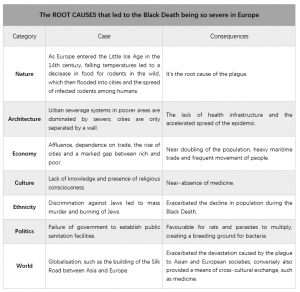This blog post was written by Di Chen, a HCRI Masters student, as part of the module Disaster Management – Theory and Application (HCRI60141). The course leader noted both the innovative style and content of the writing. For more writing from Di Chen, visit her personal blog at: https://www.whynotd.com/blog

Tragic State of Europe during the Black Death
“…might say that every day lived through brought everyone, provided he survived, twenty-four hours nearer the end of his ordeal.”
—— Albert Camus ‘The Plague’
Introduction
By examining Dr. Beak’s Black Death roots, this blog post examines the contribution to resilience made by the ‘Doctors’ as a group. Thus indicating to current disaster managers that emergency responders should focus on stress and psychological building.
Who is the Dr Beak?
If you like games, movies, or books, you may have seen a person with a bird’s beak-shaped mask, a sceptre, creepy lenses, and a black robe that wraps around his body (Fig. 1). In recent years, more and more humanistic works have used character designs inspired by the Dr Beak (Fig. 2). These designs often show images of death, gloom, and terror.


Who is Dr Beak? Why does this image frighten many? Before answering, we must understand the Black Death, the worst plague in history.
The Black Death, which ravaged Eurasia and Africa between 1347 and 1353, was the second plague epidemic and reduced the global population by up to 60%. (Benedictow, 2004).
This 10-minute animation explains the Black Death’s timeline. Link: https://youtu.be/m5q-PIN3KSE
This is a Dr Beak (Fig.3) who treated Black Death victims in mediaeval times. Due to Europe’s workforce shortage, plague practitioners were valuable to towns and cities. They became literary symbols of death and pestilence because they only appeared during plagues. People eventually saw them as the embodiment of the plague.

Fig. 3 Dr Beak’s Look
What Dr Beak can do?
Human societies have their unique vulnerability, like Jenga, and disasters occur when the bottom layer is emptied, triggering a chain of cause-and-effect and structural stresses that cause the tower to collapse violently, quickly, and inevitably (Wisner et al., 2004). Medieval Europe was vulnerable for many reasons:

According to Ritchie and Gill (2011), humans are an essential part of resilience. Doctors are potential patients, involuntary plague spreaders, communication links between dying patients and their families, and end-of-life ritual managers (Rapezzi et al., 2020).
What can Dr Beak do with this wreckage? This animation will answer some doubts. Link: https://youtu.be/u0iHnnEFUAk
Dr Beak was among the few who dared to face the plague head-on, but they could not treat it in their lifetime.
Nevertheless, they still made a significant contribution: they called for quarantine, listened to the prayers and wills of the patients, which gave them psychological comfort, and after the patients died, they counted the dead and burned the bodies, which helped contain the epidemic and stabilise society. Some doctors demanded clean water, air and the end of bloodletting.
Revisiting Dr Beak?
Whether or not they saved lives, donning beak masks symbolised the courage to restore the “Jenga.” They face death every day until they are accidentally infected, repeating tens of thousands of people’s fate. It is perhaps why the beak mask has become such a cultural symbol in today’s world (Fig. 4).

Fig.4 Beak mask from the Venice Carnival
The disease is a never-ending arms race. The plague fighters will die of disease and old age, but there will always be successors. Someone wore masks and suits to fight the Black Death, as did doctors centuries later. Someone will always be on the front lines of an epidemic, and beneath the beak doctor’s terror is the eternal heart of a healer.
Disaster management professionals should respect and tolerate doctors based on enhanced medical construction. At the same time, we should focus on emergency personnel’s physical and mental health, acknowledge the high load, stress, and risk of emergency management, and tailor psychological development to this group. Respect should substitute “death”.

Doctor of Black Death
Reference
Benedictow, O. J. (2014). The Black Death, 1346-1353: The Complete History (Boydell and Brewer, Woodbridge, UK, and Rochester, N.Y.
Rapezzi, C., Tavazzi, L., & Ferrari, R. (2020). The ‘Black Death’and the physician at the time of COVID-19.
Ritchie, L., & Gill, D. (2011). The role of community capitals in disaster recovery. Report for an online symposium sponsored by the Public Entity Research Institute.
Wisner, B., Blaikie, P., Cannon, T., & Davis, I. (2014). At risk: natural hazards, people’s vulnerability and disasters. Routledge.
Wissen Media, (2008), p. 197. https://books.google.co.uk/books?id=3DVH8dVGkX0C&pg=PA197 2. Superstock: Dr. Schnabel of Rome, a Plague Doctor in 1656 Paul Fuerst Copper engraving (Stock Photo 1443-1112)
